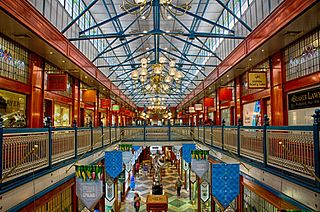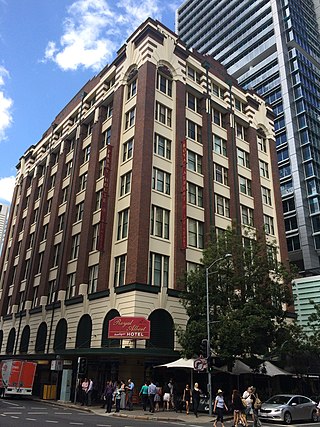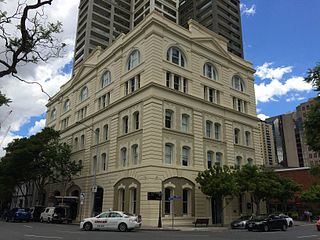
Brisbane Arcade is a heritage-listed shopping arcade at 160 Queen Street through to Adelaide Street in the Brisbane CBD, City of Brisbane, Queensland, Australia. It was designed by Richard Gailey, Junior and built in 1923 to 1924 by J & E L Rees and Forsyth & Speering, making it Brisbane's oldest shopping arcade. It was added to the Queensland Heritage Register on 21 October 1992.

Manor Apartment Hotel is a heritage-listed former office building and now apartment hotel at 289 Queen Street, Brisbane City, City of Brisbane, Queensland, Australia. It was designed by Hennessey, Hennessey & Co and built from 1930 to 1931 by Concrete Constructions (QLD) Limited. It is also known as Colonial Mutual Life Building and Newspaper House. It was added to the Queensland Heritage Register on 21 October 1992.

169 Mary Street is a heritage-listed warehouse at 169 Mary Street, Brisbane CBD, City of Brisbane, Queensland, Australia. It was designed by Richard Gailey and built from 1887 to 1888 by T Game. It is also known as Coal Board Building. It was added to the Queensland Heritage Register on 21 October 1992.

The Trustees Chambers is a heritage-listed commercial building located at 43 Queen Street, City of Brisbane, Queensland, Australia. It is currently used by the Australia and New Zealand Banking Group. It was designed by Addison & Corrie and built c. 1900 by Walter Taylor. It was also known as ANZ Bank. It was added to the Queensland Heritage Register on 21 October 1992.

The Palings Building is a heritage-listed retail building located at 86 Queen Street, Brisbane City, City of Brisbane, Queensland, Australia. It was designed by Richard Gailey as one of a row of four identical buildings and built from 1885 to 1919 by Patten & Son. Two of the four buildings have since been demolished while a third survives but is incorporated into another building. The Palings building was added to the Queensland Heritage Register on 21 October 1992; at that time, the building was used for the City International Duty Free store.

Hardy Brothers Building is a heritage-listed shop at 116 Queen Street, Brisbane City, City of Brisbane, Queensland, Australia. It was designed by Richard Gailey and built in 1881. It is also known as Love's Auction Mart. It was added to the Queensland Heritage Register on 21 October 1992.

The Edwards and Chapman Building is a heritage-listed retail warehouse at 120 Queen Street, Brisbane City, City of Brisbane, Queensland, Australia. It was designed by Francis Drummond Greville Stanley and built from 1881 to 1882 by Henry Holmes. It was added to the Queensland Heritage Register on 21 October 1992.

The Brisbane Synagogue is a heritage-listed synagogue at 98 Margaret Street, Brisbane City, City of Brisbane, Queensland, Australia. It was designed by Arthur Morry and built from 1885 to 1886 by Arthur Midson. It was added to the Queensland Heritage Register on 21 October 1992.

Perry House is a heritage-listed office building at 167 Albert Street, Brisbane City, Queensland, Australia. It was designed by Claude William Chambers and built from 1911 to 1923 by Thomas Keenan. It is also known as Royal Albert Apartments. It was added to the Queensland Heritage Register on 27 October 1994.

Wickham Hotel is a heritage-listed hotel at 308 Wickham Street, Fortitude Valley, City of Brisbane, Queensland, Australia. Originally trading as the Oriental, it was designed by Richard Gailey and built in 1885 by Cussack & O'Keefe. It was added to the Queensland Heritage Register on 21 October 1992.

MacArthur Chambers is a heritage-listed former office building at 229 Queen Street, Brisbane City, City of Brisbane, Queensland, Australia. It was designed by Francis Richard Hall and built from 1931 to 1934 by George Alexander Stronach. It was also known as the AMP Building. It was added to the Queensland Heritage Register on 21 October 1992.

The Phoenix Buildings are heritage-listed commercial buildings at 647 Stanley Street, Woolloongabba, City of Brisbane, Queensland, Australia. They were designed by Richard Gailey and built from 1889 to 1890 by James Rix. They were added to the Queensland Heritage Register on 24 May 1995.

Empire Hotel is a heritage-listed hotel at 339 Brunswick Street, Fortitude Valley, City of Brisbane, Queensland, Australia. It was designed by Richard Gailey and built in 1888 by Smith and Ball. It was renovated in 1925 to a design by Richard Gailey, Junior. It was further renovated in 1937 to incorporate apartments designed by Hall and Phillips. It was added to the Queensland Heritage Register on 21 October 1992.

Wickham House is a heritage-listed office building at 155–157 Wickham Terrace, Spring Hill, City of Brisbane, Queensland, Australia. It was designed by Francis Richard Hall and built from 1923 to 1924 by F J Corbett. It was added to the Queensland Heritage Register on 23 June 2000.

Old Mineral House is a heritage-listed warehouse at 2 Edward Street, Brisbane City, City of Brisbane, Queensland, Australia. It was designed by Richard Gailey and built from 1888 to 1890s by William Anthony. It is also known as Smellie & Co Warehouse and the Industrial High School. It was added to the Queensland Heritage Register on 21 October 1992.

Hunters Buildings is a heritage-listed group of commercial buildings at 179–191 George Street, Brisbane City, City of Brisbane, Queensland, Australia. The individual buildings are Treasury Chambers, St Francis House, and Symons Building. They were designed by Richard Gailey and built in 1886 by George Gazzard. They were added to the Queensland Heritage Register on 21 October 1992.

Watson Brothers Building is a heritage-listed warehouse at 129 Margaret Street, Brisbane City, City of Brisbane, Queensland, Australia. It was designed by Richard Gailey and built from 1887 to 1918. It was added to the Queensland Heritage Register on 23 April 1999.

The Queensland Country Life Building facade is a heritage-listed facade of a former warehouse at 424–426 Queen Street, Brisbane City, City of Brisbane, Queensland, Australia. It was designed by Richard Gailey and built from 1888 to 1889 by George Gazzard. It is also known as Hill's Buildings. It was added to the Queensland Heritage Register on 21 October 1992.

National Mutual Life Building is a heritage-listed office building at 299 Queen Street, Brisbane City, City of Brisbane, Queensland, Australia. It was designed by Gibbs, Finlay & Morsby in conjunction with Thomas Blair Moncrieff Wightman and was built in 1926 by J L Green & Sons. It is also known as Metway Chambers and Custom Credit House. It was added to the Queensland Heritage Register on 21 October 1992.

National Australia Bank is a heritage-listed bank building at 308 Queen Street, Brisbane City, City of Brisbane, Queensland, Australia. It was designed by Francis Drummond Greville Stanley and built from 1881–1924 by Southall & Tracey. It is also known as Queensland National Bank. It was added to the Queensland Heritage Register on 21 October 1992.























